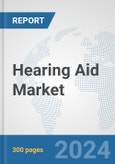Hearing loss is a serious problem caused by various factors. These factors include noise pollution, age, and genetics. Hearing aids are devices that can help people by amplifying sound waves to improve hearing. There are three main types of hearing aids: behind-the-ear, in-the-ear, and receiver-in-the-ear. The type of hearing aid that is best for a person will depend on the severity of their hearing loss and their individual needs. The market for hearing aids is growing due to the increasing prevalence of hearing loss, including age-related hearing loss and tinnitus. Hearing aids help people communicate better, reduce social isolation, and improve overall quality of life.
The adult patient segment is the largest segment of the hearing aid market. This is because hearing loss is more common in adults than in children. This is because the geriatric population is increasing worldwide, and many older adults experience hearing loss. In addition, the awareness of hearing loss and the availability of affordable hearing aids is increasing, which is also contributing to the growth of the adult segment. Hearing loss can have a significant impact on the quality of life for older adults. It can make it difficult to communicate with family and friends, participate in social activities, and enjoy hobbies. Early diagnosis, treatment of hearing loss, and use of hearing aids can help to improve the quality of life for older adults.
The global hearing aid market is projected to grow significantly, with Asia Pacific expected to be the fastest-growing region, driven by the rising geriatric population in countries like Japan and China. The aging population in Asia Pacific is a major driver of the regional market, with a significant increase in the number of individuals aged 60 and over expected by 2030. This growth in the geriatric population is expected to lead to an increase in the demand for hearing aids. Latin America is also anticipated to experience steady growth. North America is the largest market, driven by a high incidence of hearing loss cases. In Europe, the market is expected to grow steadily due to increased hearing aid usage and a growing geriatric population. In Latin America, the market growth is fueled by growing awareness of hearing loss and the availability of affordable hearing aids.
Report Findings
1) Drivers
- The surge in demand for cutting-edge hearing aids can potentially drive market expansion.
- The increasing incidence of hearing loss drives the growth of the hearing aids market.
2) Restraints
- The high cost of hearing aid devices and treatment can limit the market growth.
3) Opportunities
- Innovations such as wirelessly connected devices that integrate with smartphones are opening up new opportunities for the market.
Research Methodology
A) Primary Research
The primary research involves extensive interviews and analysis of the opinions provided by the primary respondents. The primary research starts with identifying and approaching the primary respondents, the primary respondents are approached include1. Key Opinion Leaders
2. Internal and External subject matter experts
3. Professionals and participants from the industry
The primary research respondents typically include
1. Executives working with leading companies in the market under review2. Product/brand/marketing managers
3. CXO level executives
4. Regional/zonal/country managers
5. Vice President level executives.
B) Secondary Research
Secondary research involves extensive exploring through the secondary sources of information available in both the public domain and paid sources. Each research study is based on over 500 hours of secondary research accompanied by primary research. The information obtained through the secondary sources is validated through the crosscheck on various data sources.The secondary sources of the data typically include
1. Company reports and publications2. Government/institutional publications
3. Trade and associations journals
4. Databases such as WTO, OECD, World Bank, and among others.
5. Websites and publications by research agencies
Segment Covered
The global hearing aid market is segmented on the basis of product, technology, sales channel, and patient type.The Global Hearing Aid Market by Product
- Behind-the-ear
- In-the-ear
- Receiver-in-the-ear
- In-the-canal (ITC)
- Completely-in-canal (CIC)
- Invisible-in-the-canal (IIC)
The Global Hearing Aid Market by Technology
- Analog
- Digital
The Global Hearing Aid Market by Sales Channel
- Government Purchases
- E-commerce
- Retail Sales
The Global Hearing Aid Market by Patient Type
- Adults
- Pediatrics
Company Profiles
The companies covered in the report include
- Demant A/S
- Sonova
- GN Hearing
- Cochlear Ltd.
- RION Co.,Ltd
- Starkey Laboratories, Inc.
- WS Audiology A/S
- audifon GmbH & Co. KG
- Eargo Inc.
- Audina Hearing Instruments, Inc.
What does this Report Deliver?
1. Comprehensive analysis of the global as well as regional markets of the hearing aid market.2. Complete coverage of all the segments in the hearing aid market to analyze the trends, developments in the global market and forecast of market size up to 2030.
3. Comprehensive analysis of the companies operating in the global hearing aid market. The company profile includes analysis of product portfolio, revenue, SWOT analysis and latest developments of the company.
4. Growth Matrix presents an analysis of the product segments and geographies that market players should focus to invest, consolidate, expand and/or diversify.
Table of Contents
Companies Mentioned
- Demant A/S
- Sonova
- GN Hearing
- Cochlear Ltd.
- RION Co.,Ltd
- Starkey Laboratories, Inc.
- WS Audiology A/S
- audifon GmbH & Co. KG
- Eargo Inc.
- Audina Hearing Instruments, Inc.








